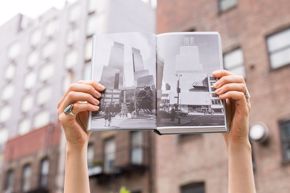Transcend the Simple Act of Seeing: Explore “10×10 Photobooks” at the Hirsch Library February 27, 2017
“A good photobook asks the reader to pick it up, smell its ink, and follow (or not follow) its sequence of images. This intimate experience is what makes a photobook special.”
We at the Hirsch Library welcome you to a hands-on experience with “CLAP! – 10×10 Contemporary Latin American Photobooks.” On March 2 & 3, members of the New York–based nonprofit organization 10×10 Photobooks visit the Hirsch Library to assist with the viewing and handling of 130 photobooks, which remain on view through April 8.
10×10 Photobooks hosts events that encourage people to engage with these unique books. Prior to cofounders Matthew Carson, Russet Lederman, and Olga Yatskevich arriving in Houston for the event, we chatted about “CLAP!” and how photobooks can, as they say, “transcend the simple act of seeing.”
What can visitors expect during the event “CLAP! – 10×10 Contemporary Latin American Photobooks” in the Hirsch Library on March 2 & 3?
10×10 Photobooks Team: The event, a hands-on reading room that shares the vast wealth found in the current Latin American photobook scene, offers an opportunity to interact with 130 books that have little or no distribution north of the Mexico border. The selection of photobooks is in no way meant to be encyclopedic; rather, it’s an invitation for discovery and future critical exploration of Latin American photography and publishing.
What does physically interacting with photobooks offer that, say, reading an e-book cannot?
Issues of design, image sequencing, scale, and print quality are very important and can’t be achieved with e-books alone. A photobook is most often a collaboration that involves not just the photographer, but also a designer, an editor, and a printer—each of whom brings something to a process that produces an object that connects with more than just sight.
The photobook experience transcends the simple act of seeing. It also includes touch and smell. A good photobook asks the reader to pick it up, smell its ink, and follow (or not follow) its sequence of images. This intimate experience is what makes a photobook special.
Do you have any favorites/recommendations for people to experience while “CLAP!” is at the Hirsch?
That is a very hard question. “CLAP!” has so many fascinating photobooks. Some are serious and deal with the tumultuous politics of Latin America, while others address personal issues of family, religion, sexuality, and creative voice. If we are forced to pick a few favorites, here is an admittedly subjective selection:
- Roberto Huarcaya, Amazogramas (2014) This book, composed of three scrolls, requires a bit of help to view, but is worth the effort! Peruvian photographer Roberto Huarcaya documents Bahuaja-Sonene National Park’s endangered tropical forests through photograms, an early photographic technique in which objects are placed on photographic paper that is then exposed to the light.
- Lourdes Grobet, Espectacular de lucha libre (2008) Mexican photographer Lourdes Grobet has been photographing the popular Mexican sport of wrestling for over 20 years. This book explores wrestling’s fundamental elements and over-the-top theatrics through more than 500 raw, honest, and often humorous photographs.
- Mauricio Toro Goya, Milagreros (2015) In this collection of Baroque painting–inspired ambrotypes—an early type of photograph where the image is made on glass rather than paper—Chilean photographer Mauricio Toro Goya emulates “ex-voto” expressions of religious characters in their gratitude for favors received and miracles granted by their gods.
- Carsten Todtmann, Todos Marchan (2005) This book’s color photographs were made in Caracas between 1998 and 2004, a period of strong social and political unrest in Venezuela. As evidence of the marches and demonstrations that mark the Chavistas and anti-Chavistas polarization of Venezuelan society, Carsten Todtmann’s images are a view from the inside.
How can people engage with these types of books on their own?
Another hard question! The reason we created the “CLAP!” reading room was because so few of the photobooks being published in Latin America were crossing the border. We think the best way to continue to interact with these books is to visit the Hirsch Library, where they have become part of the Museum’s permanent collection. Every 10×10 reading room ends with the photobooks being donated to a public institution to guarantee continued access to these materials that are rarely available through North American booksellers.
Learn more about the “CLAP!” event and drop in—it’s always free to visit the Hirsch Library.






